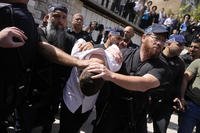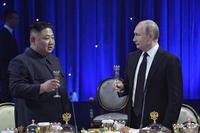
The U.S. Air Force's next-generation bomber will be used to launch nuclear payloads - a requirement that will affect the design and cost of the program, says the service's top civilian leader.
[Image from Air Force Association Magazine]
The extra cost of adding nuclear weapons delivery to the aircraft's missions could also complicate efforts to gain financial support by Pentagon leadership and Congress as they deal with a budget dominated by current operations in Afghanistan and Iraq. One defense analyst suggests the nuclear requirement can add as much as 50% to a program's price because nuclear delivery systems require a high level of redundancy in communications, command and control, and hardening against various electromagnetic pulses.
The next-generation bomber is expected to be fielded in 2018. To meet that deadline, the Air Force plans to begin a competition for a final design in Fiscal 2009. Although the B-2 remains a highly stealthy aircraft, war planners worry that the proliferation of advanced, integrated air defense systems will limit its ability to penetrate into potentially troublesome regions, such as China or Iran. The new system will incorporate stealth technologies refined after designing the F-22 and F-35, making it the stealthiest aircraft ever fielded, says Maj. Gen. David Clary, vice chief of Air Combat Command.
Candidate technologies must be mature to be considered for use on the aircraft, and - although requirements are far from refined -- senior Air Force leaders say they are placing a high priority on the system's low-observable attributes.
Going nuclear also indicates that a pilot will be on board for at least the first variant of the future system, USAF Secretary Michael Wynne acknowledges. Though the Air Force has had success adding a strike capability to its Predator unmanned aerial systems, policy makers appear hesitant to trust delivery of weapons of mass destruction to a pilotless aircraft. Wynne made his comments during a Nov. 28 speech at a conference here hosted by Credit Suisse and Aviation Week.
This squelches the hopes of unmanned vehicle advocates, who had expected the bomber to be remotely piloted at the outset. But this doesn't rule out an unmanned variant of the bomber, according to Wynne.
He says the entire bomber fleet will likely include the hardening necessary for the nuclear mission. A later variant that would be remotely piloted could handle a separate mission. This option is attractive to Air Force planners because it offers the ability to cycle through multiple pilots at remote bases, extending mission endurance two- or threefold.
One of the missions envisioned for the future bomber is to loiter without detection behind enemy lines and pick off targets or collect intelligence as needed. This, however, would require endurance and a high degree of stealth at all angles.
Read more on the next bomber from our Aviation Week friends at Military.com.
-- Christian








